Analysis of Tesco's Business and Business Environment Report
VerifiedAdded on 2021/02/20
|13
|3935
|157
Report
AI Summary
This report offers a comprehensive analysis of Tesco's business and its environment. It begins by outlining different types of businesses, including profit-oriented, non-profit, and non-governmental organizations, and then examines the size and scope of organizations, differentiating between micro, small, medium, and large businesses. The report also explores various organizational structures such as hierarchical, matrix, and flat structures, discussing their complexities. Furthermore, it delves into Tesco's operations by analyzing its HR, R&D, and marketing departments. The core of the report involves a PESTLE analysis to assess the macro-environmental factors affecting Tesco, covering political, economic, social, technological, legal, and environmental factors. A SWOT analysis is also performed to evaluate the company's internal strengths and weaknesses and external opportunities and threats. Finally, the report establishes interrelationships between internal and external factors to provide a holistic view of Tesco's business environment.
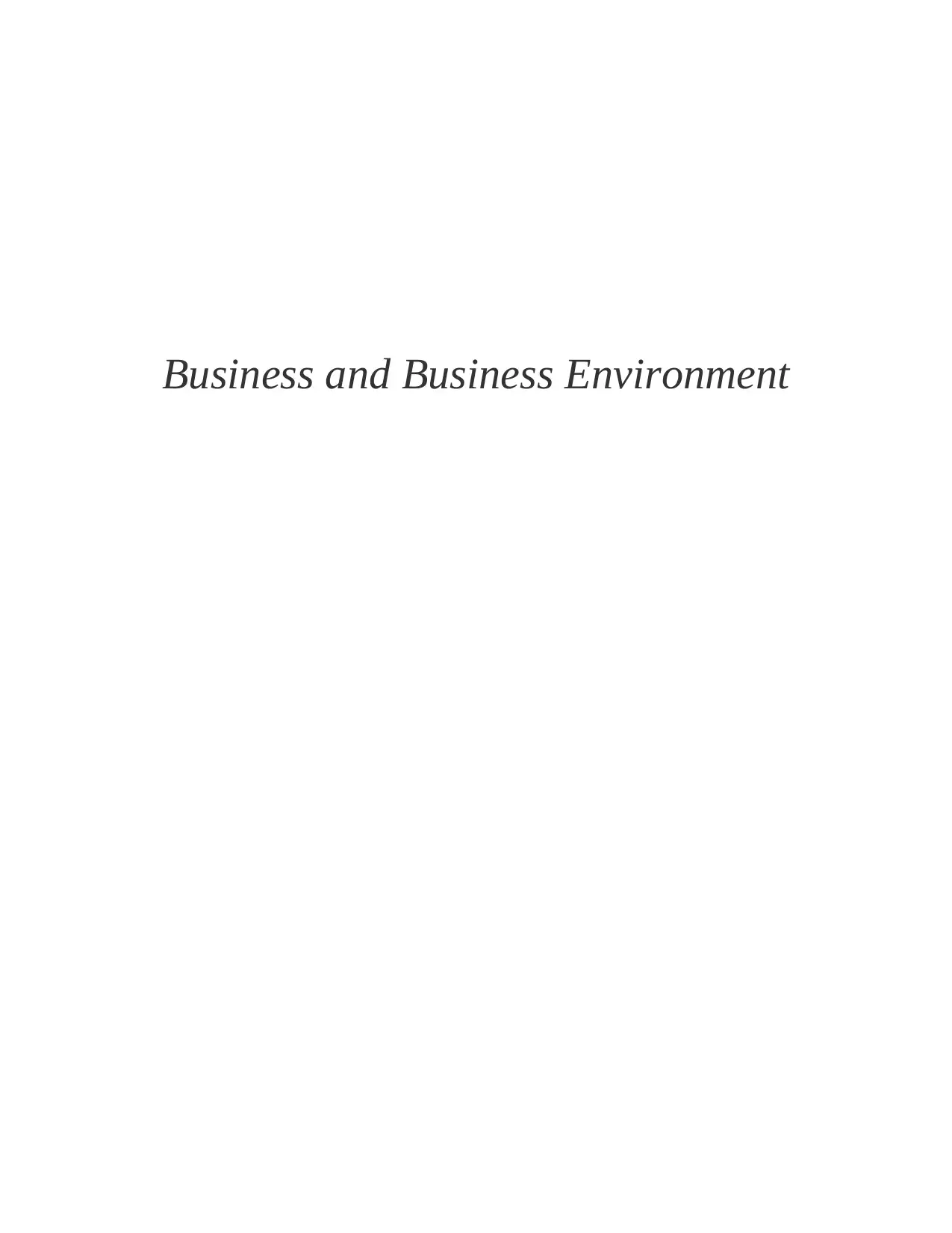
Business and Business Environment
Paraphrase This Document
Need a fresh take? Get an instant paraphrase of this document with our AI Paraphraser
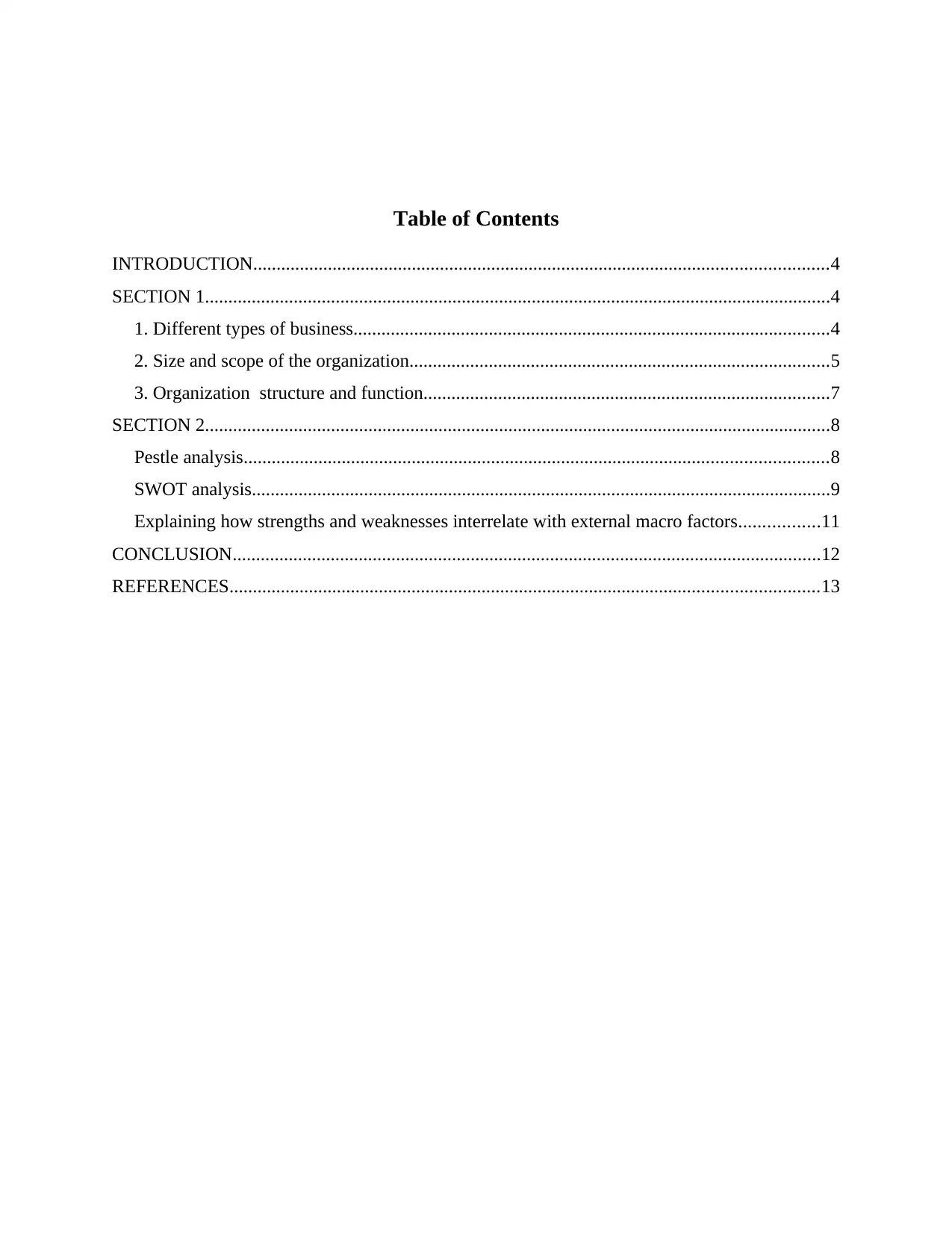
Table of Contents
INTRODUCTION...........................................................................................................................4
SECTION 1......................................................................................................................................4
1. Different types of business......................................................................................................4
2. Size and scope of the organization..........................................................................................5
3. Organization structure and function.......................................................................................7
SECTION 2......................................................................................................................................8
Pestle analysis.............................................................................................................................8
SWOT analysis............................................................................................................................9
Explaining how strengths and weaknesses interrelate with external macro factors.................11
CONCLUSION..............................................................................................................................12
REFERENCES..............................................................................................................................13
INTRODUCTION...........................................................................................................................4
SECTION 1......................................................................................................................................4
1. Different types of business......................................................................................................4
2. Size and scope of the organization..........................................................................................5
3. Organization structure and function.......................................................................................7
SECTION 2......................................................................................................................................8
Pestle analysis.............................................................................................................................8
SWOT analysis............................................................................................................................9
Explaining how strengths and weaknesses interrelate with external macro factors.................11
CONCLUSION..............................................................................................................................12
REFERENCES..............................................................................................................................13
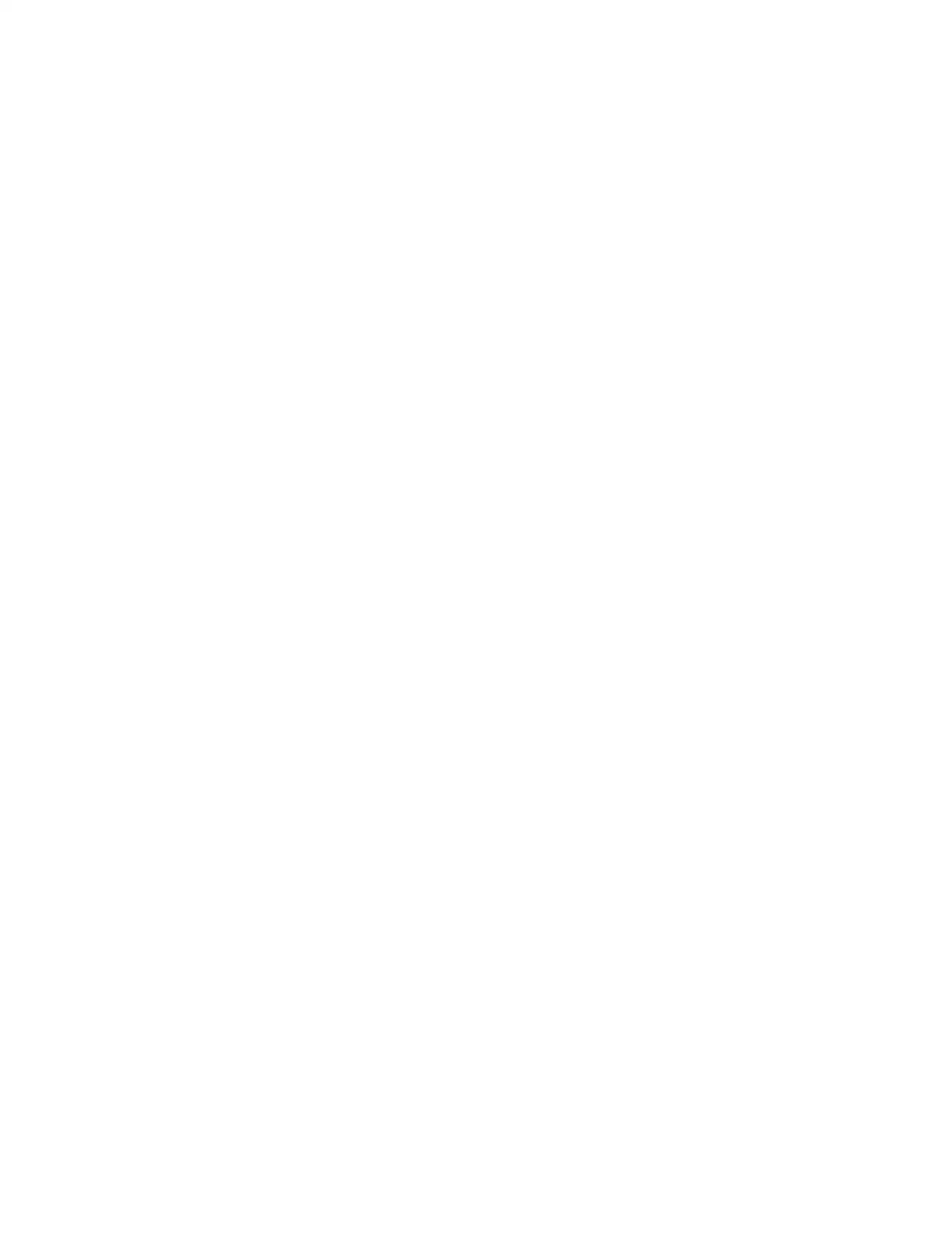
⊘ This is a preview!⊘
Do you want full access?
Subscribe today to unlock all pages.

Trusted by 1+ million students worldwide
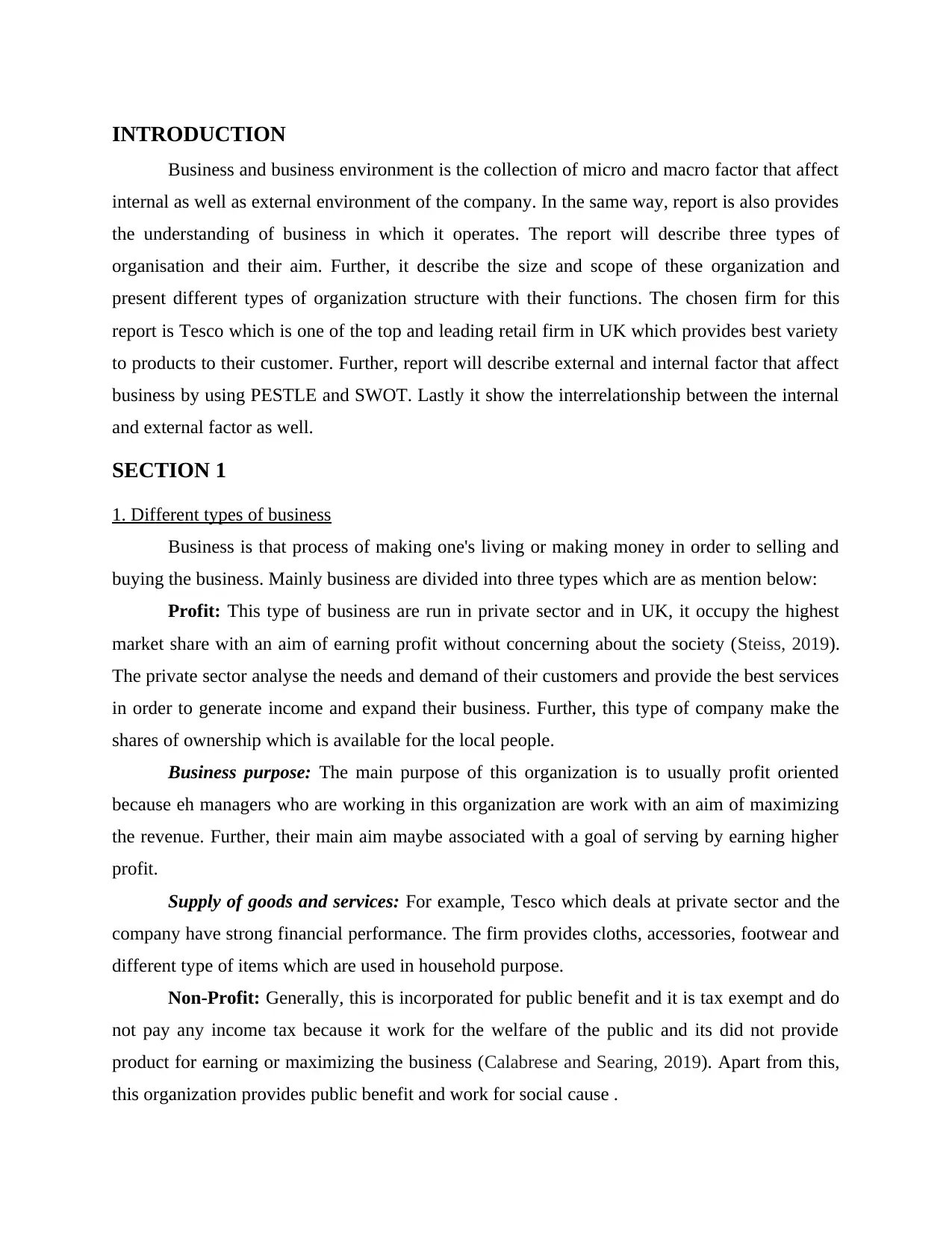
INTRODUCTION
Business and business environment is the collection of micro and macro factor that affect
internal as well as external environment of the company. In the same way, report is also provides
the understanding of business in which it operates. The report will describe three types of
organisation and their aim. Further, it describe the size and scope of these organization and
present different types of organization structure with their functions. The chosen firm for this
report is Tesco which is one of the top and leading retail firm in UK which provides best variety
to products to their customer. Further, report will describe external and internal factor that affect
business by using PESTLE and SWOT. Lastly it show the interrelationship between the internal
and external factor as well.
SECTION 1
1. Different types of business
Business is that process of making one's living or making money in order to selling and
buying the business. Mainly business are divided into three types which are as mention below:
Profit: This type of business are run in private sector and in UK, it occupy the highest
market share with an aim of earning profit without concerning about the society (Steiss, 2019).
The private sector analyse the needs and demand of their customers and provide the best services
in order to generate income and expand their business. Further, this type of company make the
shares of ownership which is available for the local people.
Business purpose: The main purpose of this organization is to usually profit oriented
because eh managers who are working in this organization are work with an aim of maximizing
the revenue. Further, their main aim maybe associated with a goal of serving by earning higher
profit.
Supply of goods and services: For example, Tesco which deals at private sector and the
company have strong financial performance. The firm provides cloths, accessories, footwear and
different type of items which are used in household purpose.
Non-Profit: Generally, this is incorporated for public benefit and it is tax exempt and do
not pay any income tax because it work for the welfare of the public and its did not provide
product for earning or maximizing the business (Calabrese and Searing, 2019). Apart from this,
this organization provides public benefit and work for social cause .
Business and business environment is the collection of micro and macro factor that affect
internal as well as external environment of the company. In the same way, report is also provides
the understanding of business in which it operates. The report will describe three types of
organisation and their aim. Further, it describe the size and scope of these organization and
present different types of organization structure with their functions. The chosen firm for this
report is Tesco which is one of the top and leading retail firm in UK which provides best variety
to products to their customer. Further, report will describe external and internal factor that affect
business by using PESTLE and SWOT. Lastly it show the interrelationship between the internal
and external factor as well.
SECTION 1
1. Different types of business
Business is that process of making one's living or making money in order to selling and
buying the business. Mainly business are divided into three types which are as mention below:
Profit: This type of business are run in private sector and in UK, it occupy the highest
market share with an aim of earning profit without concerning about the society (Steiss, 2019).
The private sector analyse the needs and demand of their customers and provide the best services
in order to generate income and expand their business. Further, this type of company make the
shares of ownership which is available for the local people.
Business purpose: The main purpose of this organization is to usually profit oriented
because eh managers who are working in this organization are work with an aim of maximizing
the revenue. Further, their main aim maybe associated with a goal of serving by earning higher
profit.
Supply of goods and services: For example, Tesco which deals at private sector and the
company have strong financial performance. The firm provides cloths, accessories, footwear and
different type of items which are used in household purpose.
Non-Profit: Generally, this is incorporated for public benefit and it is tax exempt and do
not pay any income tax because it work for the welfare of the public and its did not provide
product for earning or maximizing the business (Calabrese and Searing, 2019). Apart from this,
this organization provides public benefit and work for social cause .
Paraphrase This Document
Need a fresh take? Get an instant paraphrase of this document with our AI Paraphraser
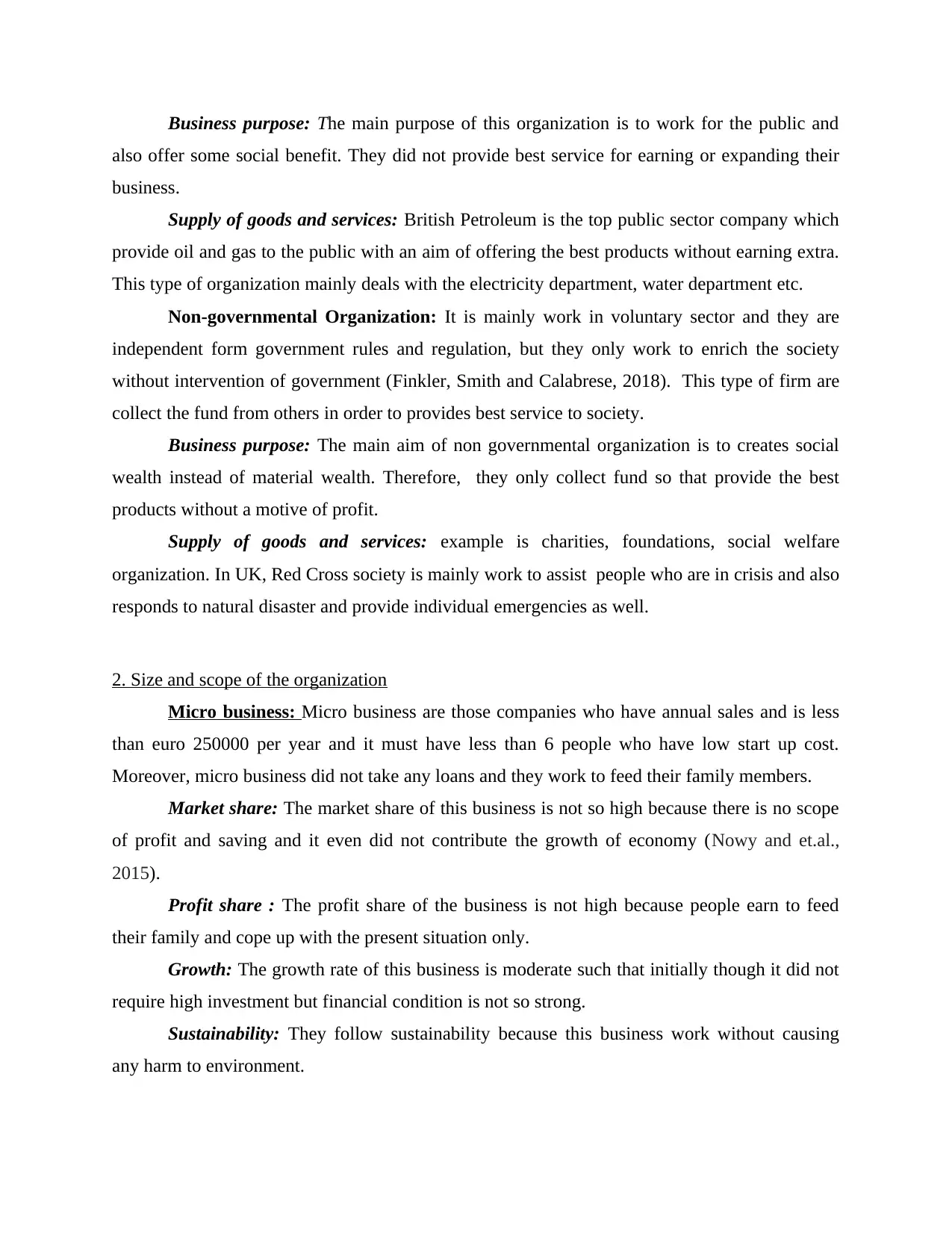
Business purpose: The main purpose of this organization is to work for the public and
also offer some social benefit. They did not provide best service for earning or expanding their
business.
Supply of goods and services: British Petroleum is the top public sector company which
provide oil and gas to the public with an aim of offering the best products without earning extra.
This type of organization mainly deals with the electricity department, water department etc.
Non-governmental Organization: It is mainly work in voluntary sector and they are
independent form government rules and regulation, but they only work to enrich the society
without intervention of government (Finkler, Smith and Calabrese, 2018). This type of firm are
collect the fund from others in order to provides best service to society.
Business purpose: The main aim of non governmental organization is to creates social
wealth instead of material wealth. Therefore, they only collect fund so that provide the best
products without a motive of profit.
Supply of goods and services: example is charities, foundations, social welfare
organization. In UK, Red Cross society is mainly work to assist people who are in crisis and also
responds to natural disaster and provide individual emergencies as well.
2. Size and scope of the organization
Micro business: Micro business are those companies who have annual sales and is less
than euro 250000 per year and it must have less than 6 people who have low start up cost.
Moreover, micro business did not take any loans and they work to feed their family members.
Market share: The market share of this business is not so high because there is no scope
of profit and saving and it even did not contribute the growth of economy (Nowy and et.al.,
2015).
Profit share : The profit share of the business is not high because people earn to feed
their family and cope up with the present situation only.
Growth: The growth rate of this business is moderate such that initially though it did not
require high investment but financial condition is not so strong.
Sustainability: They follow sustainability because this business work without causing
any harm to environment.
also offer some social benefit. They did not provide best service for earning or expanding their
business.
Supply of goods and services: British Petroleum is the top public sector company which
provide oil and gas to the public with an aim of offering the best products without earning extra.
This type of organization mainly deals with the electricity department, water department etc.
Non-governmental Organization: It is mainly work in voluntary sector and they are
independent form government rules and regulation, but they only work to enrich the society
without intervention of government (Finkler, Smith and Calabrese, 2018). This type of firm are
collect the fund from others in order to provides best service to society.
Business purpose: The main aim of non governmental organization is to creates social
wealth instead of material wealth. Therefore, they only collect fund so that provide the best
products without a motive of profit.
Supply of goods and services: example is charities, foundations, social welfare
organization. In UK, Red Cross society is mainly work to assist people who are in crisis and also
responds to natural disaster and provide individual emergencies as well.
2. Size and scope of the organization
Micro business: Micro business are those companies who have annual sales and is less
than euro 250000 per year and it must have less than 6 people who have low start up cost.
Moreover, micro business did not take any loans and they work to feed their family members.
Market share: The market share of this business is not so high because there is no scope
of profit and saving and it even did not contribute the growth of economy (Nowy and et.al.,
2015).
Profit share : The profit share of the business is not high because people earn to feed
their family and cope up with the present situation only.
Growth: The growth rate of this business is moderate such that initially though it did not
require high investment but financial condition is not so strong.
Sustainability: They follow sustainability because this business work without causing
any harm to environment.
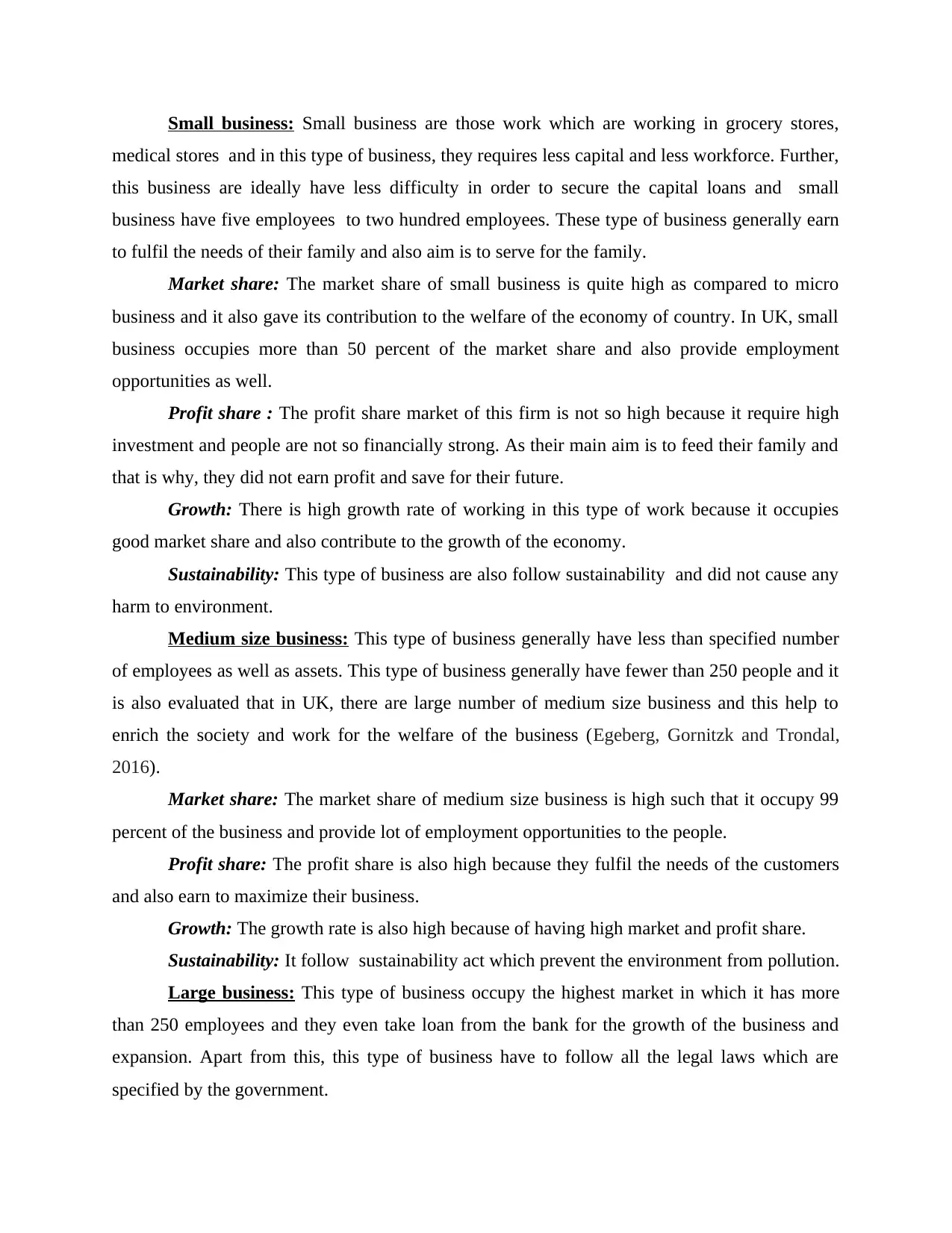
Small business: Small business are those work which are working in grocery stores,
medical stores and in this type of business, they requires less capital and less workforce. Further,
this business are ideally have less difficulty in order to secure the capital loans and small
business have five employees to two hundred employees. These type of business generally earn
to fulfil the needs of their family and also aim is to serve for the family.
Market share: The market share of small business is quite high as compared to micro
business and it also gave its contribution to the welfare of the economy of country. In UK, small
business occupies more than 50 percent of the market share and also provide employment
opportunities as well.
Profit share : The profit share market of this firm is not so high because it require high
investment and people are not so financially strong. As their main aim is to feed their family and
that is why, they did not earn profit and save for their future.
Growth: There is high growth rate of working in this type of work because it occupies
good market share and also contribute to the growth of the economy.
Sustainability: This type of business are also follow sustainability and did not cause any
harm to environment.
Medium size business: This type of business generally have less than specified number
of employees as well as assets. This type of business generally have fewer than 250 people and it
is also evaluated that in UK, there are large number of medium size business and this help to
enrich the society and work for the welfare of the business (Egeberg, Gornitzk and Trondal,
2016).
Market share: The market share of medium size business is high such that it occupy 99
percent of the business and provide lot of employment opportunities to the people.
Profit share: The profit share is also high because they fulfil the needs of the customers
and also earn to maximize their business.
Growth: The growth rate is also high because of having high market and profit share.
Sustainability: It follow sustainability act which prevent the environment from pollution.
Large business: This type of business occupy the highest market in which it has more
than 250 employees and they even take loan from the bank for the growth of the business and
expansion. Apart from this, this type of business have to follow all the legal laws which are
specified by the government.
medical stores and in this type of business, they requires less capital and less workforce. Further,
this business are ideally have less difficulty in order to secure the capital loans and small
business have five employees to two hundred employees. These type of business generally earn
to fulfil the needs of their family and also aim is to serve for the family.
Market share: The market share of small business is quite high as compared to micro
business and it also gave its contribution to the welfare of the economy of country. In UK, small
business occupies more than 50 percent of the market share and also provide employment
opportunities as well.
Profit share : The profit share market of this firm is not so high because it require high
investment and people are not so financially strong. As their main aim is to feed their family and
that is why, they did not earn profit and save for their future.
Growth: There is high growth rate of working in this type of work because it occupies
good market share and also contribute to the growth of the economy.
Sustainability: This type of business are also follow sustainability and did not cause any
harm to environment.
Medium size business: This type of business generally have less than specified number
of employees as well as assets. This type of business generally have fewer than 250 people and it
is also evaluated that in UK, there are large number of medium size business and this help to
enrich the society and work for the welfare of the business (Egeberg, Gornitzk and Trondal,
2016).
Market share: The market share of medium size business is high such that it occupy 99
percent of the business and provide lot of employment opportunities to the people.
Profit share: The profit share is also high because they fulfil the needs of the customers
and also earn to maximize their business.
Growth: The growth rate is also high because of having high market and profit share.
Sustainability: It follow sustainability act which prevent the environment from pollution.
Large business: This type of business occupy the highest market in which it has more
than 250 employees and they even take loan from the bank for the growth of the business and
expansion. Apart from this, this type of business have to follow all the legal laws which are
specified by the government.
⊘ This is a preview!⊘
Do you want full access?
Subscribe today to unlock all pages.

Trusted by 1+ million students worldwide
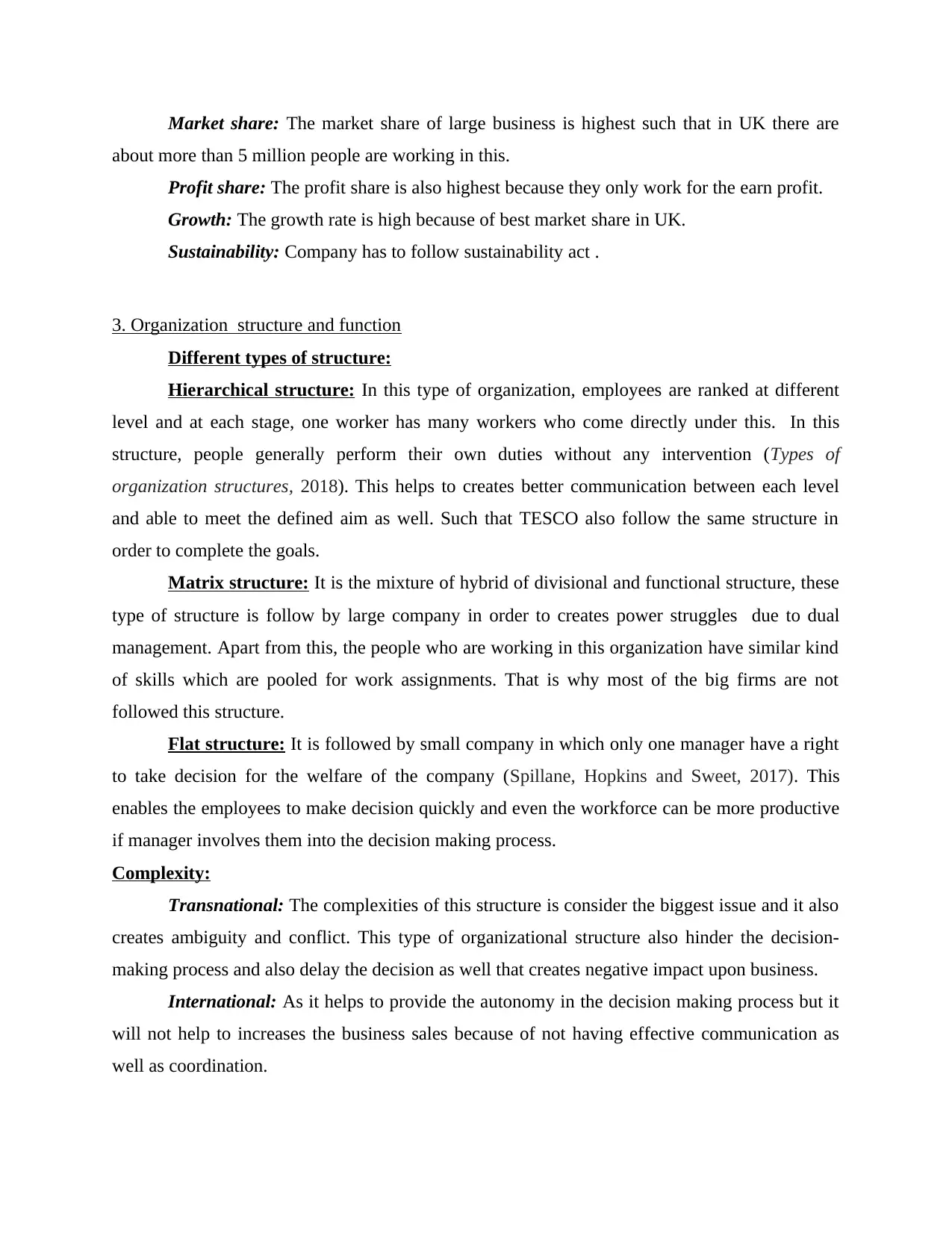
Market share: The market share of large business is highest such that in UK there are
about more than 5 million people are working in this.
Profit share: The profit share is also highest because they only work for the earn profit.
Growth: The growth rate is high because of best market share in UK.
Sustainability: Company has to follow sustainability act .
3. Organization structure and function
Different types of structure:
Hierarchical structure: In this type of organization, employees are ranked at different
level and at each stage, one worker has many workers who come directly under this. In this
structure, people generally perform their own duties without any intervention (Types of
organization structures, 2018). This helps to creates better communication between each level
and able to meet the defined aim as well. Such that TESCO also follow the same structure in
order to complete the goals.
Matrix structure: It is the mixture of hybrid of divisional and functional structure, these
type of structure is follow by large company in order to creates power struggles due to dual
management. Apart from this, the people who are working in this organization have similar kind
of skills which are pooled for work assignments. That is why most of the big firms are not
followed this structure.
Flat structure: It is followed by small company in which only one manager have a right
to take decision for the welfare of the company (Spillane, Hopkins and Sweet, 2017). This
enables the employees to make decision quickly and even the workforce can be more productive
if manager involves them into the decision making process.
Complexity:
Transnational: The complexities of this structure is consider the biggest issue and it also
creates ambiguity and conflict. This type of organizational structure also hinder the decision-
making process and also delay the decision as well that creates negative impact upon business.
International: As it helps to provide the autonomy in the decision making process but it
will not help to increases the business sales because of not having effective communication as
well as coordination.
about more than 5 million people are working in this.
Profit share: The profit share is also highest because they only work for the earn profit.
Growth: The growth rate is high because of best market share in UK.
Sustainability: Company has to follow sustainability act .
3. Organization structure and function
Different types of structure:
Hierarchical structure: In this type of organization, employees are ranked at different
level and at each stage, one worker has many workers who come directly under this. In this
structure, people generally perform their own duties without any intervention (Types of
organization structures, 2018). This helps to creates better communication between each level
and able to meet the defined aim as well. Such that TESCO also follow the same structure in
order to complete the goals.
Matrix structure: It is the mixture of hybrid of divisional and functional structure, these
type of structure is follow by large company in order to creates power struggles due to dual
management. Apart from this, the people who are working in this organization have similar kind
of skills which are pooled for work assignments. That is why most of the big firms are not
followed this structure.
Flat structure: It is followed by small company in which only one manager have a right
to take decision for the welfare of the company (Spillane, Hopkins and Sweet, 2017). This
enables the employees to make decision quickly and even the workforce can be more productive
if manager involves them into the decision making process.
Complexity:
Transnational: The complexities of this structure is consider the biggest issue and it also
creates ambiguity and conflict. This type of organizational structure also hinder the decision-
making process and also delay the decision as well that creates negative impact upon business.
International: As it helps to provide the autonomy in the decision making process but it
will not help to increases the business sales because of not having effective communication as
well as coordination.
Paraphrase This Document
Need a fresh take? Get an instant paraphrase of this document with our AI Paraphraser
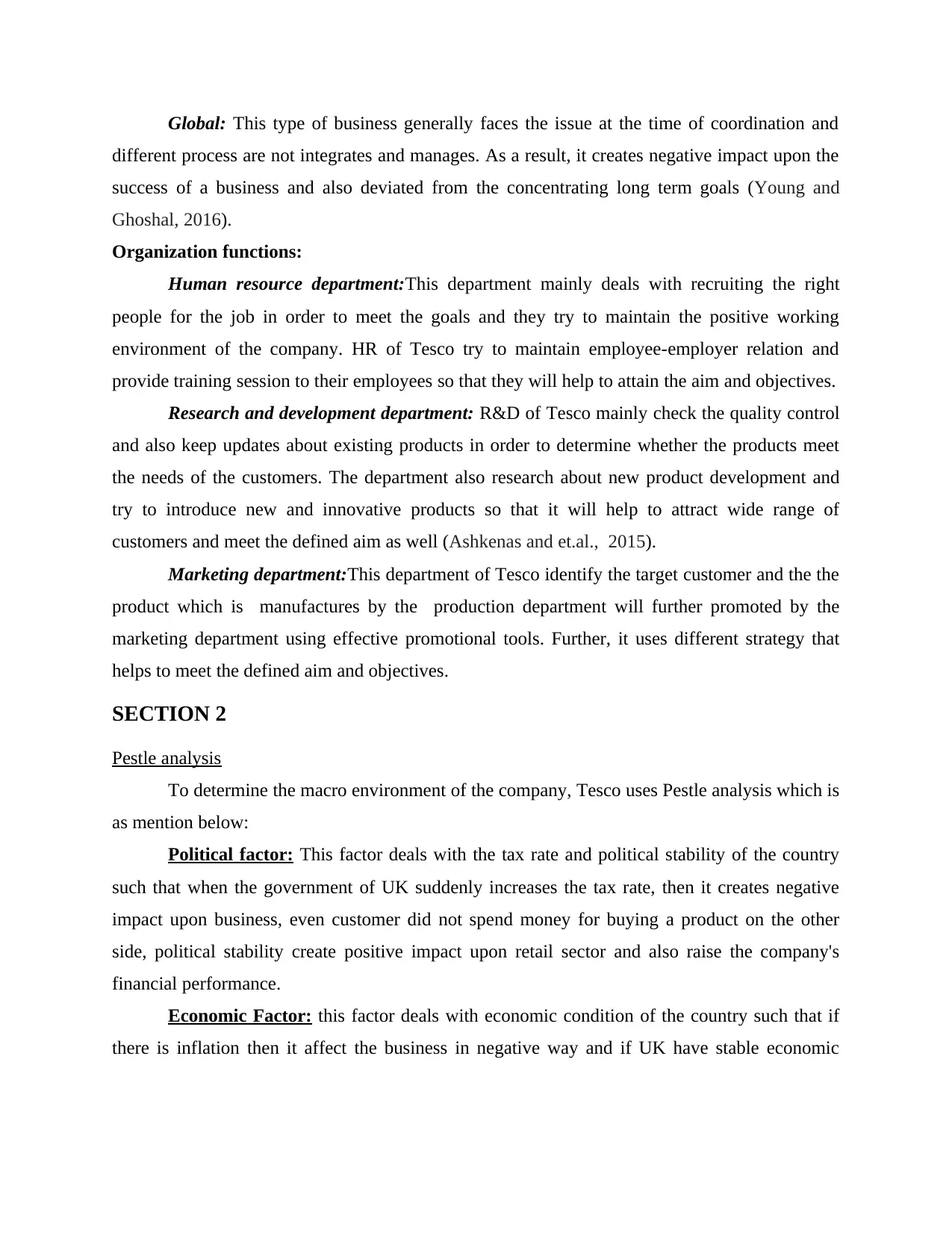
Global: This type of business generally faces the issue at the time of coordination and
different process are not integrates and manages. As a result, it creates negative impact upon the
success of a business and also deviated from the concentrating long term goals (Young and
Ghoshal, 2016).
Organization functions:
Human resource department:This department mainly deals with recruiting the right
people for the job in order to meet the goals and they try to maintain the positive working
environment of the company. HR of Tesco try to maintain employee-employer relation and
provide training session to their employees so that they will help to attain the aim and objectives.
Research and development department: R&D of Tesco mainly check the quality control
and also keep updates about existing products in order to determine whether the products meet
the needs of the customers. The department also research about new product development and
try to introduce new and innovative products so that it will help to attract wide range of
customers and meet the defined aim as well (Ashkenas and et.al., 2015).
Marketing department:This department of Tesco identify the target customer and the the
product which is manufactures by the production department will further promoted by the
marketing department using effective promotional tools. Further, it uses different strategy that
helps to meet the defined aim and objectives.
SECTION 2
Pestle analysis
To determine the macro environment of the company, Tesco uses Pestle analysis which is
as mention below:
Political factor: This factor deals with the tax rate and political stability of the country
such that when the government of UK suddenly increases the tax rate, then it creates negative
impact upon business, even customer did not spend money for buying a product on the other
side, political stability create positive impact upon retail sector and also raise the company's
financial performance.
Economic Factor: this factor deals with economic condition of the country such that if
there is inflation then it affect the business in negative way and if UK have stable economic
different process are not integrates and manages. As a result, it creates negative impact upon the
success of a business and also deviated from the concentrating long term goals (Young and
Ghoshal, 2016).
Organization functions:
Human resource department:This department mainly deals with recruiting the right
people for the job in order to meet the goals and they try to maintain the positive working
environment of the company. HR of Tesco try to maintain employee-employer relation and
provide training session to their employees so that they will help to attain the aim and objectives.
Research and development department: R&D of Tesco mainly check the quality control
and also keep updates about existing products in order to determine whether the products meet
the needs of the customers. The department also research about new product development and
try to introduce new and innovative products so that it will help to attract wide range of
customers and meet the defined aim as well (Ashkenas and et.al., 2015).
Marketing department:This department of Tesco identify the target customer and the the
product which is manufactures by the production department will further promoted by the
marketing department using effective promotional tools. Further, it uses different strategy that
helps to meet the defined aim and objectives.
SECTION 2
Pestle analysis
To determine the macro environment of the company, Tesco uses Pestle analysis which is
as mention below:
Political factor: This factor deals with the tax rate and political stability of the country
such that when the government of UK suddenly increases the tax rate, then it creates negative
impact upon business, even customer did not spend money for buying a product on the other
side, political stability create positive impact upon retail sector and also raise the company's
financial performance.
Economic Factor: this factor deals with economic condition of the country such that if
there is inflation then it affect the business in negative way and if UK have stable economic
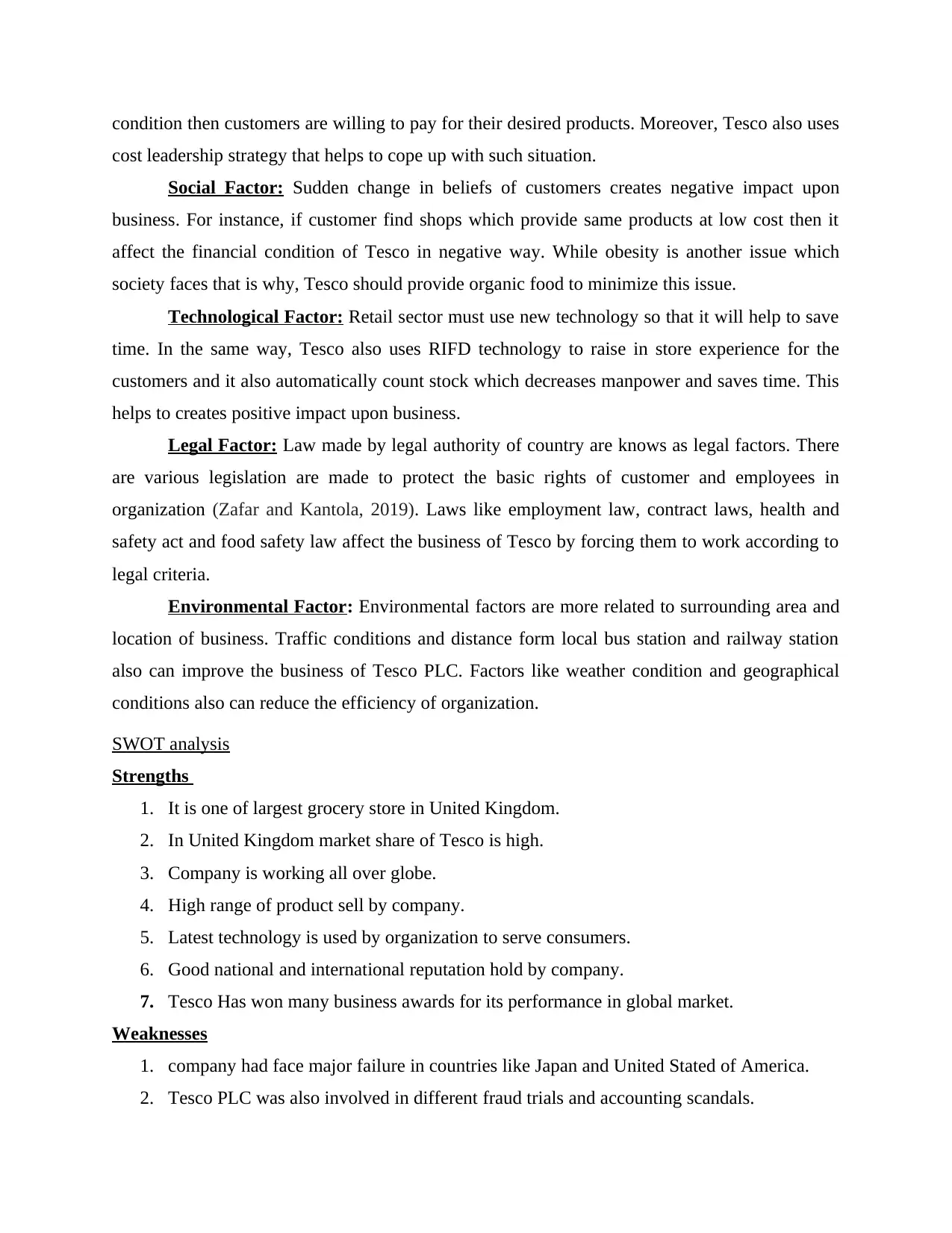
condition then customers are willing to pay for their desired products. Moreover, Tesco also uses
cost leadership strategy that helps to cope up with such situation.
Social Factor: Sudden change in beliefs of customers creates negative impact upon
business. For instance, if customer find shops which provide same products at low cost then it
affect the financial condition of Tesco in negative way. While obesity is another issue which
society faces that is why, Tesco should provide organic food to minimize this issue.
Technological Factor: Retail sector must use new technology so that it will help to save
time. In the same way, Tesco also uses RIFD technology to raise in store experience for the
customers and it also automatically count stock which decreases manpower and saves time. This
helps to creates positive impact upon business.
Legal Factor: Law made by legal authority of country are knows as legal factors. There
are various legislation are made to protect the basic rights of customer and employees in
organization (Zafar and Kantola, 2019). Laws like employment law, contract laws, health and
safety act and food safety law affect the business of Tesco by forcing them to work according to
legal criteria.
Environmental Factor: Environmental factors are more related to surrounding area and
location of business. Traffic conditions and distance form local bus station and railway station
also can improve the business of Tesco PLC. Factors like weather condition and geographical
conditions also can reduce the efficiency of organization.
SWOT analysis
Strengths
1. It is one of largest grocery store in United Kingdom.
2. In United Kingdom market share of Tesco is high.
3. Company is working all over globe.
4. High range of product sell by company.
5. Latest technology is used by organization to serve consumers.
6. Good national and international reputation hold by company.
7. Tesco Has won many business awards for its performance in global market.
Weaknesses
1. company had face major failure in countries like Japan and United Stated of America.
2. Tesco PLC was also involved in different fraud trials and accounting scandals.
cost leadership strategy that helps to cope up with such situation.
Social Factor: Sudden change in beliefs of customers creates negative impact upon
business. For instance, if customer find shops which provide same products at low cost then it
affect the financial condition of Tesco in negative way. While obesity is another issue which
society faces that is why, Tesco should provide organic food to minimize this issue.
Technological Factor: Retail sector must use new technology so that it will help to save
time. In the same way, Tesco also uses RIFD technology to raise in store experience for the
customers and it also automatically count stock which decreases manpower and saves time. This
helps to creates positive impact upon business.
Legal Factor: Law made by legal authority of country are knows as legal factors. There
are various legislation are made to protect the basic rights of customer and employees in
organization (Zafar and Kantola, 2019). Laws like employment law, contract laws, health and
safety act and food safety law affect the business of Tesco by forcing them to work according to
legal criteria.
Environmental Factor: Environmental factors are more related to surrounding area and
location of business. Traffic conditions and distance form local bus station and railway station
also can improve the business of Tesco PLC. Factors like weather condition and geographical
conditions also can reduce the efficiency of organization.
SWOT analysis
Strengths
1. It is one of largest grocery store in United Kingdom.
2. In United Kingdom market share of Tesco is high.
3. Company is working all over globe.
4. High range of product sell by company.
5. Latest technology is used by organization to serve consumers.
6. Good national and international reputation hold by company.
7. Tesco Has won many business awards for its performance in global market.
Weaknesses
1. company had face major failure in countries like Japan and United Stated of America.
2. Tesco PLC was also involved in different fraud trials and accounting scandals.
⊘ This is a preview!⊘
Do you want full access?
Subscribe today to unlock all pages.

Trusted by 1+ million students worldwide
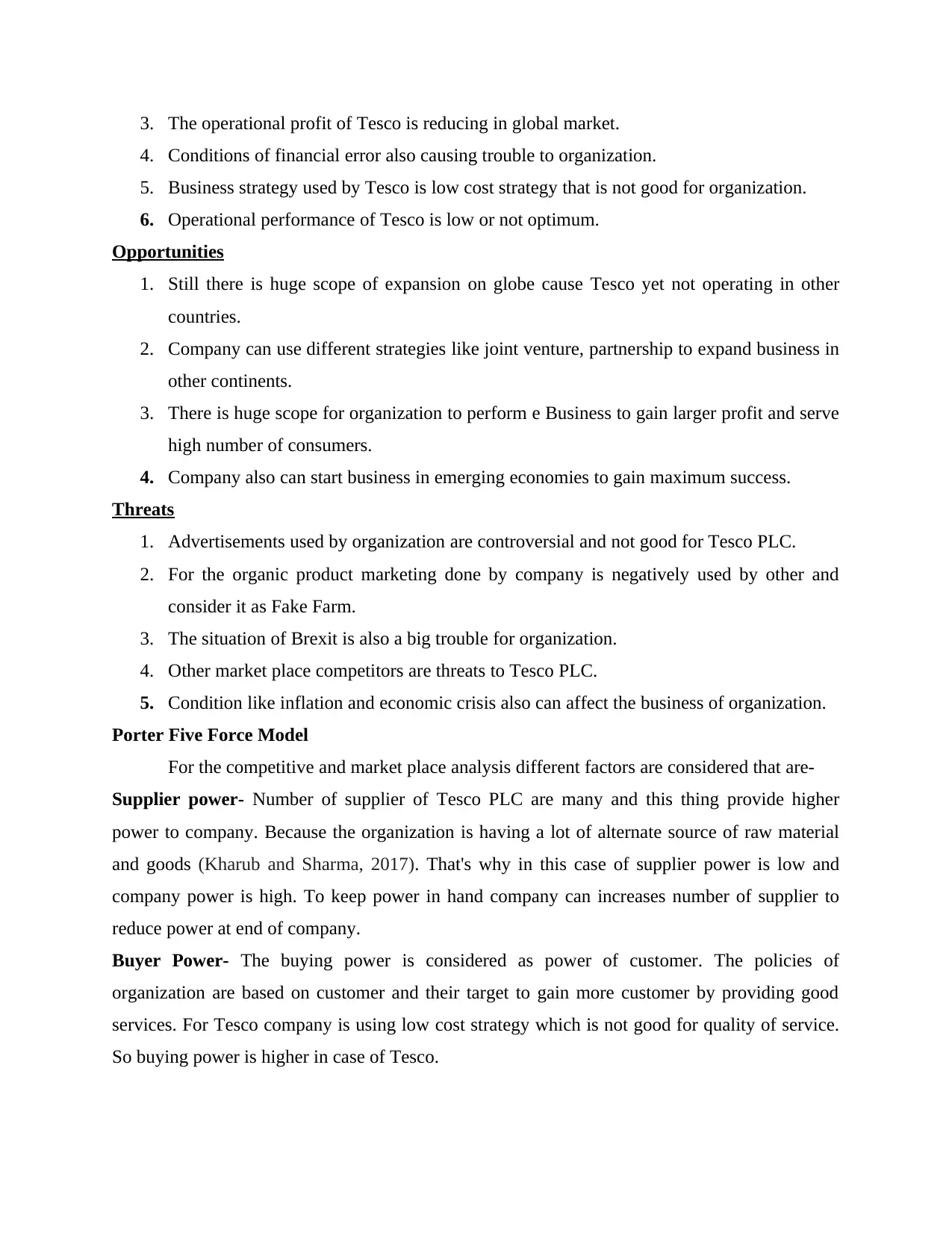
3. The operational profit of Tesco is reducing in global market.
4. Conditions of financial error also causing trouble to organization.
5. Business strategy used by Tesco is low cost strategy that is not good for organization.
6. Operational performance of Tesco is low or not optimum.
Opportunities
1. Still there is huge scope of expansion on globe cause Tesco yet not operating in other
countries.
2. Company can use different strategies like joint venture, partnership to expand business in
other continents.
3. There is huge scope for organization to perform e Business to gain larger profit and serve
high number of consumers.
4. Company also can start business in emerging economies to gain maximum success.
Threats
1. Advertisements used by organization are controversial and not good for Tesco PLC.
2. For the organic product marketing done by company is negatively used by other and
consider it as Fake Farm.
3. The situation of Brexit is also a big trouble for organization.
4. Other market place competitors are threats to Tesco PLC.
5. Condition like inflation and economic crisis also can affect the business of organization.
Porter Five Force Model
For the competitive and market place analysis different factors are considered that are-
Supplier power- Number of supplier of Tesco PLC are many and this thing provide higher
power to company. Because the organization is having a lot of alternate source of raw material
and goods (Kharub and Sharma, 2017). That's why in this case of supplier power is low and
company power is high. To keep power in hand company can increases number of supplier to
reduce power at end of company.
Buyer Power- The buying power is considered as power of customer. The policies of
organization are based on customer and their target to gain more customer by providing good
services. For Tesco company is using low cost strategy which is not good for quality of service.
So buying power is higher in case of Tesco.
4. Conditions of financial error also causing trouble to organization.
5. Business strategy used by Tesco is low cost strategy that is not good for organization.
6. Operational performance of Tesco is low or not optimum.
Opportunities
1. Still there is huge scope of expansion on globe cause Tesco yet not operating in other
countries.
2. Company can use different strategies like joint venture, partnership to expand business in
other continents.
3. There is huge scope for organization to perform e Business to gain larger profit and serve
high number of consumers.
4. Company also can start business in emerging economies to gain maximum success.
Threats
1. Advertisements used by organization are controversial and not good for Tesco PLC.
2. For the organic product marketing done by company is negatively used by other and
consider it as Fake Farm.
3. The situation of Brexit is also a big trouble for organization.
4. Other market place competitors are threats to Tesco PLC.
5. Condition like inflation and economic crisis also can affect the business of organization.
Porter Five Force Model
For the competitive and market place analysis different factors are considered that are-
Supplier power- Number of supplier of Tesco PLC are many and this thing provide higher
power to company. Because the organization is having a lot of alternate source of raw material
and goods (Kharub and Sharma, 2017). That's why in this case of supplier power is low and
company power is high. To keep power in hand company can increases number of supplier to
reduce power at end of company.
Buyer Power- The buying power is considered as power of customer. The policies of
organization are based on customer and their target to gain more customer by providing good
services. For Tesco company is using low cost strategy which is not good for quality of service.
So buying power is higher in case of Tesco.
Paraphrase This Document
Need a fresh take? Get an instant paraphrase of this document with our AI Paraphraser
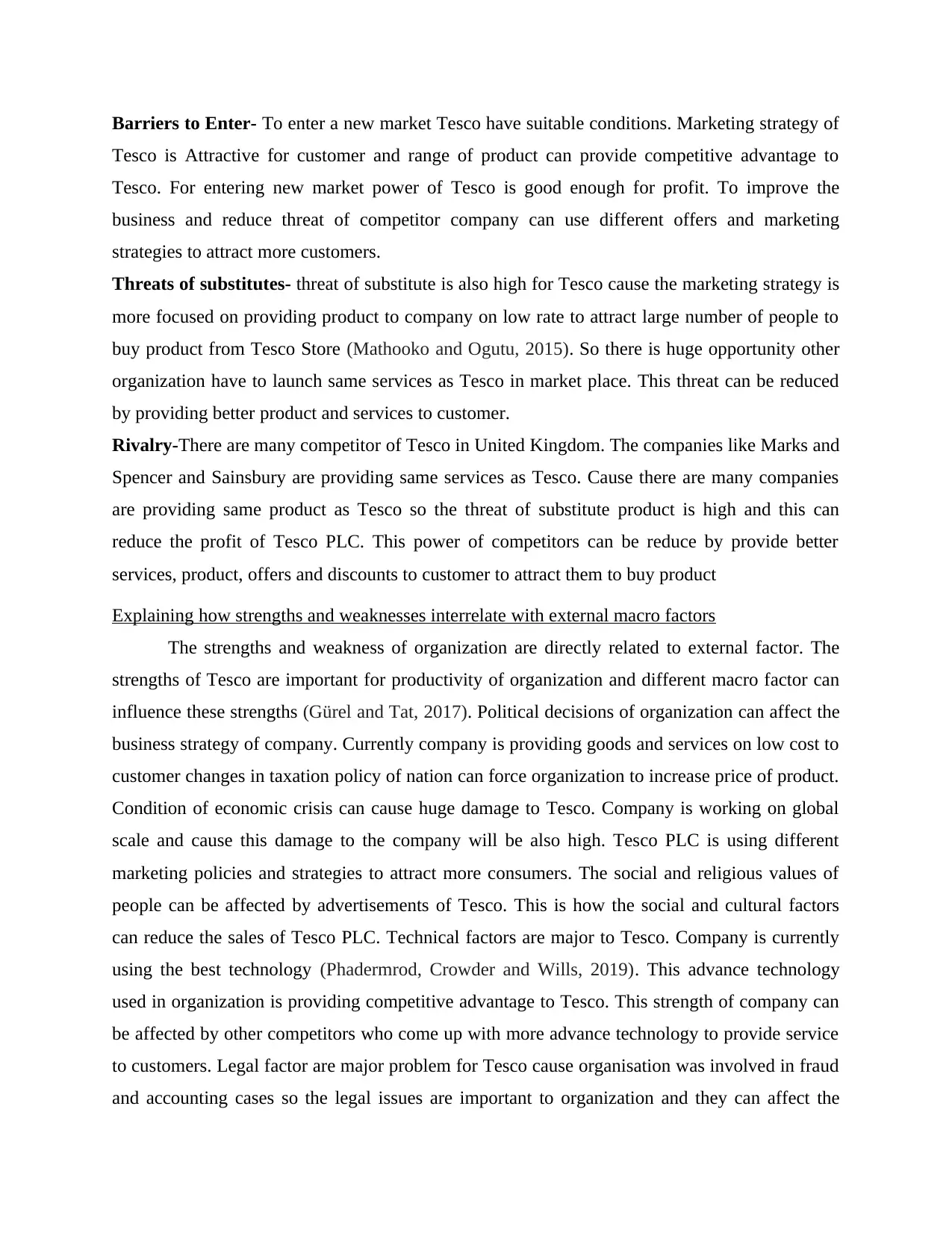
Barriers to Enter- To enter a new market Tesco have suitable conditions. Marketing strategy of
Tesco is Attractive for customer and range of product can provide competitive advantage to
Tesco. For entering new market power of Tesco is good enough for profit. To improve the
business and reduce threat of competitor company can use different offers and marketing
strategies to attract more customers.
Threats of substitutes- threat of substitute is also high for Tesco cause the marketing strategy is
more focused on providing product to company on low rate to attract large number of people to
buy product from Tesco Store (Mathooko and Ogutu, 2015). So there is huge opportunity other
organization have to launch same services as Tesco in market place. This threat can be reduced
by providing better product and services to customer.
Rivalry-There are many competitor of Tesco in United Kingdom. The companies like Marks and
Spencer and Sainsbury are providing same services as Tesco. Cause there are many companies
are providing same product as Tesco so the threat of substitute product is high and this can
reduce the profit of Tesco PLC. This power of competitors can be reduce by provide better
services, product, offers and discounts to customer to attract them to buy product
Explaining how strengths and weaknesses interrelate with external macro factors
The strengths and weakness of organization are directly related to external factor. The
strengths of Tesco are important for productivity of organization and different macro factor can
influence these strengths (Gürel and Tat, 2017). Political decisions of organization can affect the
business strategy of company. Currently company is providing goods and services on low cost to
customer changes in taxation policy of nation can force organization to increase price of product.
Condition of economic crisis can cause huge damage to Tesco. Company is working on global
scale and cause this damage to the company will be also high. Tesco PLC is using different
marketing policies and strategies to attract more consumers. The social and religious values of
people can be affected by advertisements of Tesco. This is how the social and cultural factors
can reduce the sales of Tesco PLC. Technical factors are major to Tesco. Company is currently
using the best technology (Phadermrod, Crowder and Wills, 2019). This advance technology
used in organization is providing competitive advantage to Tesco. This strength of company can
be affected by other competitors who come up with more advance technology to provide service
to customers. Legal factor are major problem for Tesco cause organisation was involved in fraud
and accounting cases so the legal issues are important to organization and they can affect the
Tesco is Attractive for customer and range of product can provide competitive advantage to
Tesco. For entering new market power of Tesco is good enough for profit. To improve the
business and reduce threat of competitor company can use different offers and marketing
strategies to attract more customers.
Threats of substitutes- threat of substitute is also high for Tesco cause the marketing strategy is
more focused on providing product to company on low rate to attract large number of people to
buy product from Tesco Store (Mathooko and Ogutu, 2015). So there is huge opportunity other
organization have to launch same services as Tesco in market place. This threat can be reduced
by providing better product and services to customer.
Rivalry-There are many competitor of Tesco in United Kingdom. The companies like Marks and
Spencer and Sainsbury are providing same services as Tesco. Cause there are many companies
are providing same product as Tesco so the threat of substitute product is high and this can
reduce the profit of Tesco PLC. This power of competitors can be reduce by provide better
services, product, offers and discounts to customer to attract them to buy product
Explaining how strengths and weaknesses interrelate with external macro factors
The strengths and weakness of organization are directly related to external factor. The
strengths of Tesco are important for productivity of organization and different macro factor can
influence these strengths (Gürel and Tat, 2017). Political decisions of organization can affect the
business strategy of company. Currently company is providing goods and services on low cost to
customer changes in taxation policy of nation can force organization to increase price of product.
Condition of economic crisis can cause huge damage to Tesco. Company is working on global
scale and cause this damage to the company will be also high. Tesco PLC is using different
marketing policies and strategies to attract more consumers. The social and religious values of
people can be affected by advertisements of Tesco. This is how the social and cultural factors
can reduce the sales of Tesco PLC. Technical factors are major to Tesco. Company is currently
using the best technology (Phadermrod, Crowder and Wills, 2019). This advance technology
used in organization is providing competitive advantage to Tesco. This strength of company can
be affected by other competitors who come up with more advance technology to provide service
to customers. Legal factor are major problem for Tesco cause organisation was involved in fraud
and accounting cases so the legal issues are important to organization and they can affect the
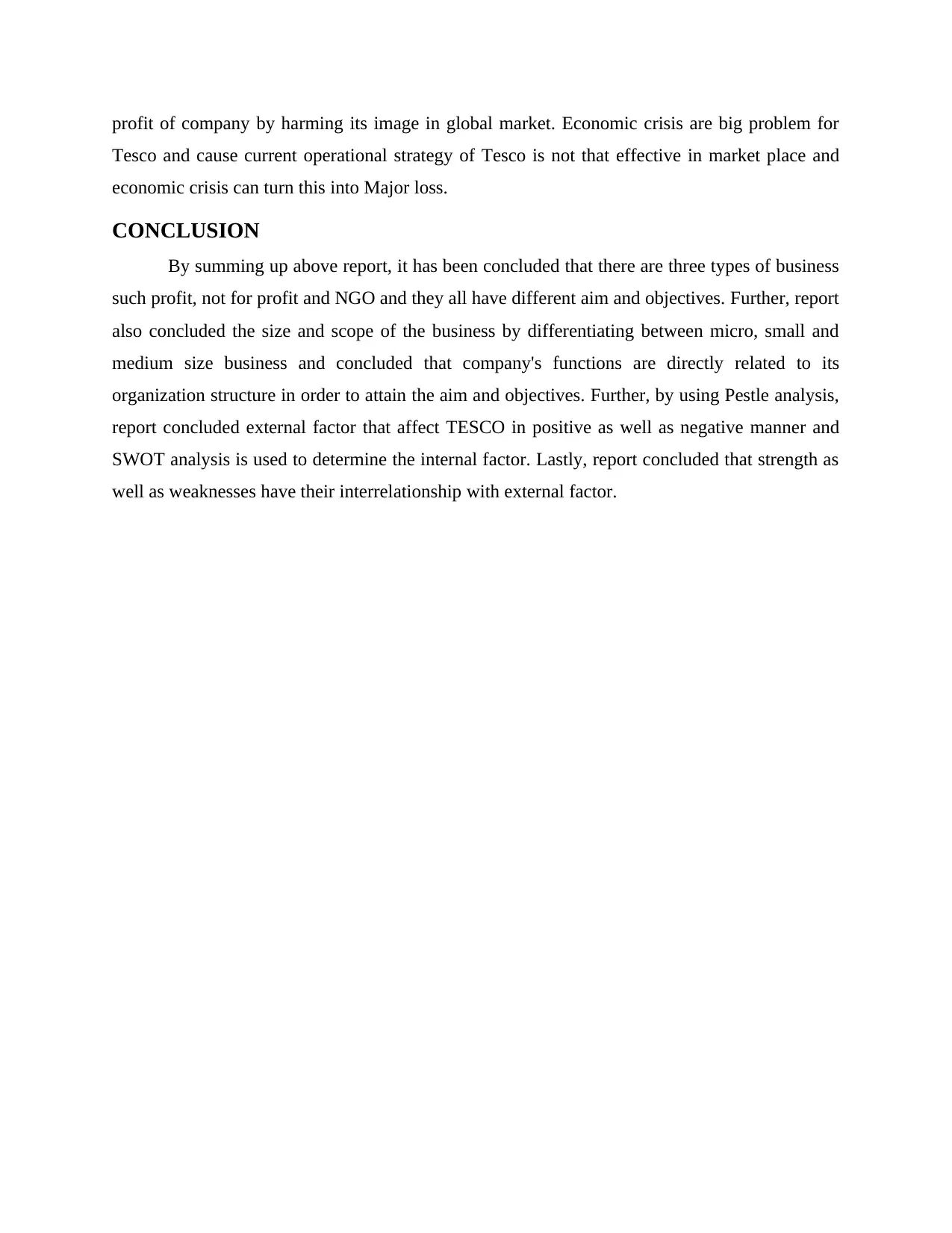
profit of company by harming its image in global market. Economic crisis are big problem for
Tesco and cause current operational strategy of Tesco is not that effective in market place and
economic crisis can turn this into Major loss.
CONCLUSION
By summing up above report, it has been concluded that there are three types of business
such profit, not for profit and NGO and they all have different aim and objectives. Further, report
also concluded the size and scope of the business by differentiating between micro, small and
medium size business and concluded that company's functions are directly related to its
organization structure in order to attain the aim and objectives. Further, by using Pestle analysis,
report concluded external factor that affect TESCO in positive as well as negative manner and
SWOT analysis is used to determine the internal factor. Lastly, report concluded that strength as
well as weaknesses have their interrelationship with external factor.
Tesco and cause current operational strategy of Tesco is not that effective in market place and
economic crisis can turn this into Major loss.
CONCLUSION
By summing up above report, it has been concluded that there are three types of business
such profit, not for profit and NGO and they all have different aim and objectives. Further, report
also concluded the size and scope of the business by differentiating between micro, small and
medium size business and concluded that company's functions are directly related to its
organization structure in order to attain the aim and objectives. Further, by using Pestle analysis,
report concluded external factor that affect TESCO in positive as well as negative manner and
SWOT analysis is used to determine the internal factor. Lastly, report concluded that strength as
well as weaknesses have their interrelationship with external factor.
⊘ This is a preview!⊘
Do you want full access?
Subscribe today to unlock all pages.

Trusted by 1+ million students worldwide
1 out of 13
Related Documents
Your All-in-One AI-Powered Toolkit for Academic Success.
+13062052269
info@desklib.com
Available 24*7 on WhatsApp / Email
![[object Object]](/_next/static/media/star-bottom.7253800d.svg)
Unlock your academic potential
Copyright © 2020–2025 A2Z Services. All Rights Reserved. Developed and managed by ZUCOL.





